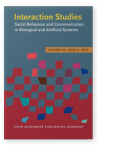Vol. 22:2 (2021) ► pp.177–211
An empirical study on integrating a small humanoid robot to support the therapy of children with Autism Spectrum Disorder and Intellectual Disability
Recent research showed the potential benefits of robot-assisted therapy in treating children with Autism Spectrum Disorder. These children often have some form of Intellectual Disability (ID) too, but this has mainly been neglected by previous robotics research. This article presents an empirical evaluation of robot-assisted imitation training, where the child imitated the robot, integrated into the Treatment and Education of Autistic and related Communication handicapped Children (TEACCH) program. The sample included six hospitalized children with different levels of ID, from mild to profound. We applied mixed methods to assess their progress, during treatment and three months later. Results show increased Gross Motor Imitation skills in the children, except for those with profound ID and the therapists’ positive attitude towards the humanoid robot. Furthermore, the therapists suggest how a robot could be used to autonomously collect and analyze the information obtained in the rehabilitation training for a continuous evaluation of the participants.
Article outline
- 1.Introduction
- 2.Material and methods
- 2.1Participants
- 2.2Therapists’ role and prompts
- 2.3Setting and materials
- 2.3.1The robotic-assisted therapy
- 2.3.2Questionnaire for the evaluation of therapists’ experience
- 2.4Design of the study
- 2.5Procedure
- 2.5.1Phase A – first baseline (Ex-ante evaluation with the therapist)
- 2.5.2Phase B – intervention
- 2.5.3Phase A – second baseline (Ex-post evaluation with the therapist)
- 2.5.4Phase A′ – robotic baseline (evaluation with the robot)
- 2.5.5Follow-up evaluation (3 months later)
- 2.6Quantitative measures for the evaluation of video recorded by the Robot
- 3.Results
- Participant 1 (P01)
- Participant 2 (P02)
- Participant 3 (P03)
- Participant 4 (P04)
- Participant 5 (P05)
- Participant 6 (P06)
- 3.1Evaluation of the therapists’ opinion
- 4.Discussion and conclusions
- Acknowledgements
- Author contributions
- Compliance with ethical standards
-
References
